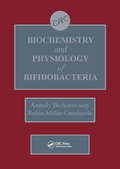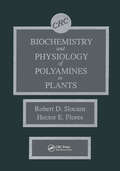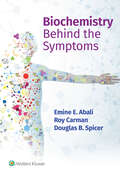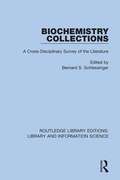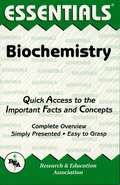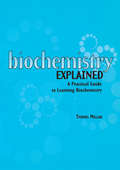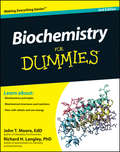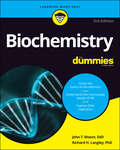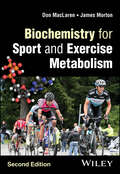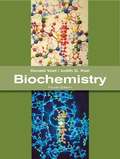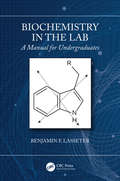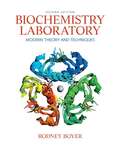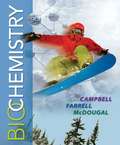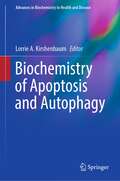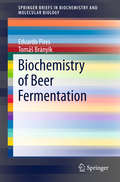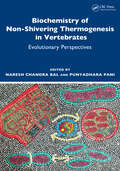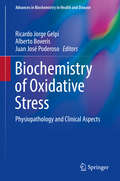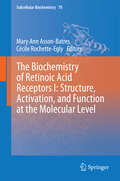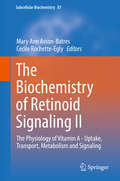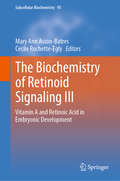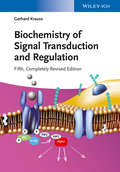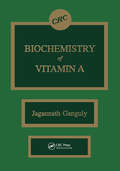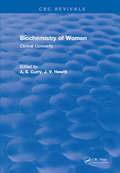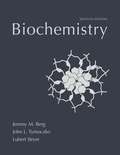- Table View
- List View
Biochemistry and Physiology of Bifidobacteria
by Anatoly BezkorovainyThis book provides a comprehensive reference work on this ubiquitous group of microorganisms for the biomedical community, and intends to stimulate further research into the biochemistry and physiology of bifidobacteria and their role in health and disease of newborns and even adult human beings. Discussions of bifidobacteria include chapters on nomenclature and taxonomy, ecology, morphology, metabolism, membrane and cell wall structure, clinical applications, metal transport, and future research trends. Each chapter ends with a summary. The book is amply illustrated and extensively referenced.
Biochemistry and Physiology of Polyamines in Plants
by Robert D. Slocum Hector E. FloresBiochemistry and Physiology of Polyamines in Plants provides a comprehensive introduction to commonly used methods in polyamine research and the problems unique to plant studies. Topics discussed include polyamine metabolism in plants, the functions of polyamines in plant growth and development, and an examination of analytical methods for polyamines and enzymes of polyamine metabolism. Agronomists, plant physiologists, and biochemists interested in polyamines in plants will find this book to be a valuable reference resource.
Biochemistry Behind the Symptoms
by Emine E. Abali Roy Carman Douglas SpicerBiochemistry Behind the Symptoms takes a problem-based approach to understanding and applying biochemistry for superior clinical outcomes. Organized around the common symptoms encountered by clinicians, this engaging text clarifies the connections between foundational science and clinical manifestations to help users form confident diagnoses throughout their clerkship and beyond. Each chapter explores the biochemical concepts behind underlying causes and demonstrates their ties to presenting symptoms through 5 realistic patient cases. Accompanying questions encourage discussion and guide users in building accurate differential diagnoses. Ideal for peer-to-peer learning environments or independent study, this practical approach strengthens users’ application of fundamental knowledge and ensures the long-term retention essential to clinical success.
Biochemistry Collections: A Cross-Disciplinary Survey of the Literature (Routledge Library Editions: Library and Information Science #10)
by Bernard S. SchlessingerThis book, first published in 1982, offers an examination of the special nature of biochemistry collections. It focuses on the production, control, and use of the literature – diverse in nature, and analysed here by specialist contributors.
Biochemistry Essentials
by Jay TemplinREA's Essentials provide quick and easy access to critical information in a variety of different fields, ranging from the most basic to the most advanced. As its name implies, these concise, comprehensive study guides summarize the essentials of the field covered. Essentials are helpful when preparing for exams, doing homework and will remain a lasting reference source for students, teachers, and professionals. Biochemistry includes biological structure, chemistry of proteins, enzymes, bioenergetics, carbohydrates, lipids, metabolism of amino acids and proteins, nucleic acids, and extra cellular and intracellular fluids.
Biochemistry Explained: A Practical Guide to Learning Biochemistry
by Thomas MillarBiochemistry Explained employs an innovative approach which has proven highly successful in the author's own classes. The author establishes a thorough understanding of the foundations of and common linkages between molecular structures and reactions, so that eventual interpretation of complex biochemical pathways and reactions is easy. All of the major molecular structures and biochemical pathways are explained, and, for the most part, these center on mammalian biochemistry. The text is supported by biochemical nomenclature and questions to bear in mind while reading. Higher learning sections are also provided for advanced students. Written in an informal, conversational style, this textbook will serve as an invaluable resource for any student who is struggling with the standard texts and for postgraduate students who need to refresh their knowledge.
Biochemistry For Dummies
by John T. Moore Richard H. LangleyGrasp biochemistry basics, apply the science, and ace your examsAre you baffled by biochemistry? If so here's the good news ? you don't have to stay that way! Biochemistry For Dummies shows you how to get a handle on biochemistry, apply the science, raise your grades, and prepare yourself to ace any standardized test.This friendly, unintimidating guide presents an overview of the material covered in a typical college-level biochemistry course and makes the subject easy to understand and accessible to everyone. From cell ultrastructure and carbohydrates to amino acids, proteins, and supramolecular structure, you'll identify biochemical structures and reactions, and send your grades soaring. Newest biology, biochemistry, chemistry, and scientific discoveriesUpdated examples and explanationsIncorporates the most current teaching techniquesFrom water biochemistry to protein synthesis, Biochemistry For Dummies gives you the vital information, clear explanations, and important insights you need to increase your understanding and improve your performance on any biochemistry test.
Biochemistry For Dummies
by John T. Moore Richard H. LangleyIt’s alive! It’s alive! (Thanks to biochemistry, that is.) Biochemistry is the science of the chemical processes that allow for…well…life. If it moves, breathes, eats, or sleeps, biochemistry can probably explain how. So, it stands to reason that the fundamentals of biochemistry can get a little complicated. In Biochemistry For Dummies, you’ll explore the carbons, proteins, and cellular systems that make up the biochemical processes that create and sustain life of all kinds. Perfect for students majoring in biology, chemistry, pre-med, health-services, and other science-related fields, this book tracks a typical college-level biochemistry class. It simplifies and clarifies the subject with easy-to-follow diagrams and real-world examples. You’ll also get: Explorations of cell biology, carbohydrates, proteins, lipids, and other fundamental building blocks of life Discussions of the basic structures common to all living organisms Treatments of the microscopic details of life that make us all tick If you’re looking for a hand with some of the trickier parts of biochemistry—or you just need an accessible overview of the subject—check out Biochemistry For Dummies today!
Biochemistry for Sport and Exercise Metabolism
by James Morton Donald MacLarenAll-new edition of an introductory textbook on sport and exercise biochemistry and muscle metabolism Biochemistry for Sport and Exercise Metabolism initially examines the essence of the biochemistry of the macronutrients before exploring how exercise mode, intensity, and duration, training status, and nutritional status affects the regulation of energy producing pathways, enabling readers to apply this understanding to develop training and nutrition programs that maximize athletic performance. This textbook includes an overview of energy metabolism, skeletal muscle structure and function and related biochemical concepts, carbohydrates, lipids, and proteins, metabolism, regulation of metabolism, and factors that can influence metabolism, and fatigue. This revised and updated second edition reflects some of the latest advances in the field, with new content on metabolic regulation as well as adaptations to high intensity and strength exercise, endurance exercise, and intermittent exercise. Furthermore, there is a new chapter on biochemical techniques to provide some pertinent background on how reported metabolic changes during exercise are achieved. This textbook features learning objectives, keywords, and key points in each chapter to aid in reader comprehension and reinforce information retention. Written by two highly qualified authors, Biochemistry for Sport and Exercise Metabolism discusses sample topics including: How the energy supply for muscle contraction is achieved from carbohydrates, lipids and protein Muscle contraction, covering propagation of the action potential, excitation-contraction coupling, and the sliding filament mechanismRegulation of the energy systems providing energy for exerciseTechniques for exercise metabolism, including respiratory analysis, ergometry, blood sampling, metabolomics, a-v differences, muscle biopsy, and isotopesExploration of the metabolic events occurring during high intensity, endurance, and high-intensity intermittent forms of exercise Clearly written and completely comprehensive, the second edition of Biochemistry for Sport and Exercise Metabolism continues to be an invaluable learning resource for students across a wide range of sport-related courses.
Biochemistry Fourth Edition
by Donald Voet Judith G. VoetThe "Gold Standard" in Biochemistry text books, Biochemistry 4e, is a modern classic that has been thoroughly revised. Don and Judy Voet explain biochemical concepts while offering a unified presentation of life and its variation through evolution. Incorporates both classical and current research to illustrate the historical source of much of our biochemical knowledge.
Biochemistry in the Lab: A Manual for Undergraduates
by Benjamin LasseterMost lab manuals assume a high level of knowledge among biochemistry students, as well as a large amount of experience combining knowledge from separate scientific disciplines. Biochemistry in the Lab: A Manual for Undergraduates expects little more than basic chemistry. It explains procedures clearly, as well as giving a clear explanation of the theoretical reason for those steps. Key Features: Presents a comprehensive approach to modern biochemistry laboratory teaching, together with a complete experimental experience Includes chemical biology as its foundation, teaching readers experimental methods specific to the field Provides instructor experiments that are easy to prepare and execute, at comparatively low cost Supersedes existing, older texts with information that is adjusted to modern experimental biochemistry Is written by an expert in the field This textbook presents a foundational approach to modern biochemistry laboratory teaching together with a complete experimental experience, from protein purification and characterization to advanced analytical techniques. It has modules to help instructors present the techniques used in a time critical manner, as well as several modules to study protein chemistry, including gel techniques, enzymology, crystal growth, unfolding studies, and fluorescence. It proceeds from the simplest and most important techniques to the most difficult and specialized ones. It offers instructors experiments that are easy to prepare and execute, at comparatively low cost.
Biochemistry Laboratory: Modern Theory and Techniques
by Rodney BoyerYour biochemistry lab course is an essential component in training for a career in biochemistry, molecular biology, chemistry, and related molecular life sciences such as cell biology, neurosciences, and genetics. <p><p>Biochemistry Laboratory: Modern Theory and Techniques covers the theories, techniques, and methodologies practiced in the biochemistry teaching and research lab. Instead of specific experiments, it focuses on detailed descriptions of modern techniques in experimental biochemistry and discusses the theory behind such techniques in detail. An extensive range of techniques discussed includes Internet databases, chromatography, spectroscopy, and recombinant DNA techniques such as molecular cloning and PCR. <p><p>The Second Edition introduces cutting-edge topics such as membrane-based chromatography, adds new exercises and problems throughout, and offers a completely updated Companion Website.
Biochemistry (Ninth Edition)
by Mary Campbell Shawn Farrell Owen M. McDougalIdeal for those studying biochemistry for the first time, this proven book balances scientific detail with readability and shows you how principles of biochemistry affect your everyday life. Designed throughout to help you succeed (and excel!), the book includes in-text questions that help you master key concepts, end-of-chapter problem sets grouped by problem type that help you prepare for exams, and state-of-the art visuals that help you understand key processes and concepts. In addition, visually dynamic Hot Topics cover the latest advances in the field, while Biochemical Connections demonstrate how biochemistry affects other fields, such as health and sports medicine.
Biochemistry of Apoptosis and Autophagy (Advances in Biochemistry in Health and Disease #18)
by Lorrie A. KirshenbaumOne of the most intriguing and compelling issues to impact contemporary biology to date is the concept that cell death is genetically regulated. Observations by Kerr and Wyllie, made more than 30 years ago on the basis of distinct morphological criteria, markedly distinguished apoptosis from classical cell death by necrosis. Apoptosis is a highly regulated, evolutionary conserved, genetic program of cell death essential for normal development and tissue homeostasis. The discovery of apoptosis as a regulated event and potentially amenable to therapeutic interventions has generated considerable excitement because it meant that disease entities resulting from either too much, or too little, apoptosis could be potentially cured with new therapies that target apoptosis.While there is little doubt that necrosis induced by massive cellular trauma is likely an unregulated event, several lines of investigation have challenged the dogma that necrotic cell death is merely unregulated. Emerging data has shifted the paradigm in our thinking about necrosis as a regulated event.Autophagy is another cellular process that has received considerable attention over the past two decades and its remarkable involvement in the processes of cell survival, death and tumorigenesis. Macro autophagy is a catabolic process that involves the selective and targeted removal of oxidized proteins, macromolecular structures and organelles through an elaborate cellular process involving a lysosome mediated pathway. Other forms of autophagy involving adapter proteins, commonly referred to as chaperone mediated autophagy, involves the selective removal of cellular cargo by the ubiquitin-proteasome pathway.The book will serve as a reference guide for basic and clinical scientists who are interested in understanding how these critical cellular processes impact the pathogenesis of human disease.
Biochemistry of Beer Fermentation (SpringerBriefs in Biochemistry and Molecular Biology)
by Eduardo Pires Tomáš BrányikBeer is the most popular alcoholic beverage in the world. Yet, behind each glass of beer there is an enormous amount of work invested. If the first image that comes to your mind is the lifting of heavy bags of malt or carrying kegs, guess again! Most of the work involved in brewing is carried out by "microworkers" - yeast and their enzymes! These special helpers are responsible for catalyzing the vast majority of the biochemical reactions occurring in all steps that gradually transform the sugary wort into beer. This book not only provides readers with an overview of the whole biochemical process involved in beer fermentation, but also reviews the latest findings in this delightful field, making it essential reading for both scientists and brewing enthusiasts
Biochemistry of Non-Shivering Thermogenesis in Vertebrates: Evolutionary Perspectives
by Naresh Chandra Bal Punyadhara PaniThis comprehensive reference book covers non-shivering thermogenesis, metabolic rates, and associated diseases. It emphasizes the phylogenetic relations of vertebrate non-shivering thermogenesis (NST) and its evolutionary significance. The book describes how the incidence of metabolic syndromes has reached epidemic levels worldwide due to dysregulation in energy balance. Chapters include the evolution and regulatory mechanisms of NSTs. It covers the role of NST in birds and wild animals, and muscle adaptation during hibernation. The book is meant for researchers and students of biochemistry, molecular medicine, and physiology. It is also useful to physicians and health care professionals.Key Features: Provides in-depth insights on topics related to metabolic rate regulation and thermogenesis Covers the evolution of tachymetabolism and endothermy among vertebrates Analyzes the evolutionary perspectives of non-shivering thermogenesis in different organisms Discusses the evolution of brown adipose tissue and non-shivering thermogenesis in mammals Provides graphs, flowcharts, and descriptive figures for easy understanding of concepts
Biochemistry of Oxidative Stress: Physiopathology and Clinical Aspects (Advances in Biochemistry in Health and Disease #16)
by Ricardo Jorge Gelpi Alberto Boveris Juan José PoderosoThe strongest point of this book titled "Biochemistry of Oxidative Stress: Physiopathology and Clinical Aspects", is that the academic and scientific background of the authors/editors guarantee the authorship of a book comprising all aspects of oxidative stress, ranging from very molecular aspects, to clinical application, including the antioxidant therapy. Of particular importance is the fact that the aforementioned aspects are described in the book in a general section and in three different and important pathologies, such as cardiovascular diseases, neurodegenerative diseases, and cancer. The importance of these pathologies lays in the fact that, taken separately or together, they represent by far the leading cause of death in the world. Finally, all the chapters have been written by highly recognized authorities in the field of their investigations. At least to our knowledge, this is the first book with this characteristics in the field of oxidative stress.
The Biochemistry of Retinoic Acid Receptors I: Structure, Activation, and Function at the Molecular Level
by Mary Ann Asson-Batres Cécile Rochette-EglyA role for vitamin A in living organisms has been known throughout human history. In the last 100 years, the biochemical nature of vitamin A and its active derivative, retinoic acid, its physiological impact on growth processes and the essential details of its mechanism of action have been revealed by investigations carried out by researchers using vertebrate and more recently invertebrate models to study a multiplicity of processes and conditions, encompassing embryogenesis, postnatal development to old age. A wealth of intercellular interactions, intracellular signaling systems and molecular mechanisms have been described and the overall conclusion is that retinoic acid is essential for life. This book series, with chapters authored by experts in every aspect of this complex field, unifies the knowledge base and mechanisms currently known in detailed, engaging, well-illustrated, focused chapters that synthesize information for each specific area. In view of the recent explosion in this field, it is timely to publish a contemporary, comprehensive, book series recapitulating the most exciting developments in the field and covering fundamental research in molecular mechanisms of vitamin A action, its role in physiology, development and continued well-being and the potential of vitamin A derivatives and synthetic mimetics to serve as therapeutic treatments for cancers and other debilitating human diseases. VOLUME I: Here, we present the first volume of a multi-volume series on Retinoic Acid Signaling that will cover all aspects of this broad and diverse field. One aim of Volume I is to present a compilation of topics related to the biochemistry of nuclear retinoic acid receptors, from their architecture when bound to DNA and associated with their coregulators to their ability to regulate target gene transcription. A second aim is to provide insight into recent advances that have been made in identifying novel targets and non-genomic effects of retinoic acid. Volume I is divided into ten chapters contributed by prominent experts in their respective fields. Each chapter starts with the history of the area of research. Then, the key findings that contributed to development of the field are described, followed by a detailed look at key findings and progress that are being made in current, ongoing research. Each chapter is concluded with a discussion of the relevance of the research and a perspective on missing pieces and lingering gaps that the author recommends will be important in defining future directions in vitamin A research.
The Biochemistry of Retinoid Signaling II
by Mary Ann Asson-Batres Cecile Rochette-EglyThe role of vitamin A in living organisms has been known throughout human history. In the last 100 years, the biochemical nature of vitamin A and its active derivative, retinoic acid, its physiological impact on growth processes, and the essential details of its mechanism of action have been revealed by investigations carried out by researchers using vertebrate and more recently invertebrate models to study a multiplicity of processes and conditions, encompassing embryogenesis, postnatal development to old age. A wealth of intercellular interactions, intracellular signaling systems, and molecular mechanisms have been described and the overall conclusion is that retinoic acid is essential for life. This book series, with chapters authored by experts in every aspect of this complex field, unifies the knowledge base and mechanisms currently known in detailed, engaging, well-illustrated, focused chapters that synthesize information for each specific area. In view of the recent information explosion in this field, it is timely to publish a contemporary, comprehensive, book series recapitulating the most exciting developments in the field and covering fundamental research in molecular mechanisms of vitamin A action, its role in physiology, development, and continued well-being, and the potential of vitamin A derivatives and synthetic mimetics to serve as therapeutic treatments for cancers and other debilitating human diseases. Volume II is divided into nine chapters contributed by prominent experts in their respective fields. Each chapter starts with the history of the area of research. Then, the key findings that contributed to development of the field are described, followed by a detailed look at key findings and progress that are being made in current, ongoing research. Each chapter is concluded with a discussion of the relevance of the research and a perspective on missing pieces and lingering gaps that the author recommends will be important in defining future directions in vitamin A research.
The Biochemistry of Retinoid Signaling III: Vitamin A and Retinoic Acid in Embryonic Development (Subcellular Biochemistry #95)
by Mary Ann Asson-Batres Cecile Rochette-EglyThis book covers subjects that have major impacts on society, such as the mechanism of maternal-fetal transfer of vitamin A, and the effects of alcohol on retinoic acid signaling and mammalian embryonic development. There has been an awareness of the importance of consuming vitamins throughout human history, but empirical studies of their physiological role and mode of action only began about 150 years ago. Since then, the biochemical nature of vitamin A and its active derivative, retinoic acid, have been identified and researchers around the globe have investigated retinoic acid’s physiological function in growth processes and in maintaining life Written by leading experts, this book discusses the latest findings and advances in retinoic acid research. It addresses topics such as the role of retinoic acid signaling in a multitude of processes, including limb, heart and respiratory system development, as well as its role in maintaining postnatal organ systems. This book is a valuable resource for scientists involved in vitamin A/retinoic acid research and readers interested in developmental biology.
Biochemistry of Signal Transduction and Regulation
by Gerhard KraussOriginally based on a graduate course taught by the author, this true classic has once again been extensively updated to incorporate key new findings in biological signaling. With over half of the content re-written, plus 70 brand new and 50 revised figures, this is the most up-to-date textbook on signaling available anywhere.Thanks to its clear structure, hundreds of illustrative drawings, as well as chapter introductions and newly added study questions, this text excels as a companion for a course on biological signaling, and equally as an introductory reference to the field for students and researchers. Generations of students and junior researchers have relied on "the Krauss" to find their way through the bewildering complexity of biological signaling pathways.
Biochemistry of Vitamin A
by Jagannath GangulyThe main emphasis of this text is on the biochemistry, metabolism and systemic mode of action of vitamin A. The physiological, biochemical and nutritional aspects of naturally occurring retinoids are clearly addressed. Chapters review biogenesis, absorption, storage, transport, and metabolic transformations of vitamin A. Further discussion includes vision and bacteriorhodopsin, vitamin A deficiency and hypervitaminosis A, and the vitamin A in prevention and cure of cancer.
Biochemistry of Women: Clinical Concepts
by A.S CurryThis book concerns the clinical chemistry of women � from conception to the grave. It concerns their medical problems and the laboratories� role in elucidating these and in monitoring treatment. The book represents the current �state of the art� and although in many areas there are sometimes widely divergent opinions, it is good that these should be aired so that problem areas can be revealed and opinions revised when further experimental work is done as a consequence.
Biochemistry of Women Methods: For Clinical Investigation
by A.S. CurryThis book is written by experts who, using the latest techniques, describe laboratory investigations into women from conception to the grave. We asked the authors tp pay particular attention to the interpretation of laboratory results so we hope the book will be of interest to clinicians as well as to medical scientists.
Biochemistry Seventh Edition
by Jeremy M. Berg John L. Tymoczko Lubert StryerSince its first edition in 1975, this extraordinary textbook has helped shape the way biochemistry is taught, offering exceptionally clear writing, innovative graphics, coverage of the latest research techniques and advances, and a signature emphasis on physiological and medical relevance. Those defining features are at the heart of the new Seventh Edition of Biochemistry, which again communicates fundamental concepts and the latest breakthroughs in a way that makes the information engaging and understandable for students approaching the subject for the first time.
